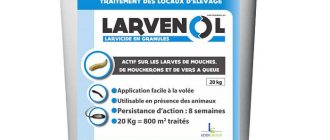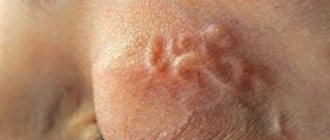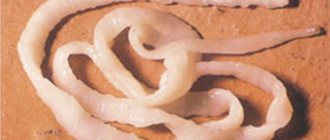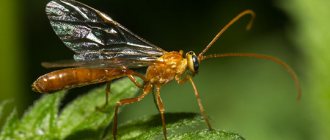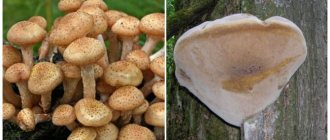What helminths can live in pollock?
Helminths are creatures that can live in any organ, it all depends on the type of worm.
It is impossible to independently determine whether a fish is infected with parasites using the “eye” method!
Helminth eggs enter fish through river mollusks
Entire laboratory studies are necessary, since parasites live in both the muscles and the digestive organs. This is not a complete list of their locations. But despite this, it is strictly forbidden to refuse fish products! This is dangerous to your health.
| Parasite | Disease | Description | Symptoms of infection |
| Siberian fluke | Opisthorchiasis | The dimensions of the parasite are miniature from 5 to 12 mm. It lives in the ducts of the liver and gall bladder, and the worm also parasitizes the pancreas. | Opisthorchiasis has common symptoms of helminthiasis: weakness, fatigue, fever, a feeling of bitterness in the mouth, and an aversion to fatty foods. |
| Chinese fluke | Clonorchiasis | This parasite is larger than the Siberian fluke, measuring up to 25 mm. Its body does not seem to be a narrow elongated leaf. It has a reddish translucent color. The habitat is the same. | Clonorchiasis causes various allergic skin reactions, hyperthermia and liver enlargement. |
| Wide tapeworm | Diphyllobothriasis | Reaches gigantic sizes of 10 m or more in the human body! It has a white-yellow long and thin body. | A patient with diphyllobothriasis has increased salivation and decreased appetite. The person experiences a feeling of nausea and vomiting. This causes even greater weakness and fatigue. The patient's stool is loose. In addition to physical suffering, the patient also experiences mental disorders - aggression and irritability for no reason. |
| Metagonimus yokogawai | Metagonimiasis | “Mini-parasites” measuring about 2 mm. Localized in the intestines. | After 10 days from the moment of infection, the patient begins to notice that something wrong is happening to him. He experiences diarrhea, a skin rash, hyperthermia, and severe colon pain. |
Is it possible to eat fish with worms?
If worms are found in fish, it must be specially treated or destroyed. If you bought fish and found worms in it, then it must be frozen for at least two weeks and then properly thermally treated. In any case, well-cooked and fried fish will be absolutely safe for human health. You can eat fish with worms, but only after proper treatment and removal of the worms, if this does not cause disgust. If there are too many worms, it is better to throw away the fish and not even feed it to your cat.
It is impossible to say for sure whether it is possible to eat fish with worms. Not even all experts can give an accurate answer. The best way to take preventative measures is to never eat raw or lightly salted fish. In such conditions, there are all risks of infection. If you still cannot avoid the temptation, then it is best to eat only artificially grown fish.
Is it harmful to eat herring with worms? Well-salted fish does not contain dangerous worms; they simply die. To insure yourself against unpredictable situations, choose the right products - look at the eyes of the fish. If they fall out or become cloudy, refuse to purchase. Try to buy food only from trusted retail outlets that undergo sanitary control. This way you can avoid many problems.
Everyone who was born in the Soviet Union remembers that Thursday is fish day. Pensioners are nostalgic for the times when fish was prepared for visitors in canteens on Thursdays. The government introduced this measure to take care of the health of its citizens.
It is generally accepted that there are no helminths in marine fish. But studies conducted in 2007 proved that 40% of sea fish are affected by worms. The most affordable sea fish is pollock. Are there helminths in it? How dangerous is it for humans to eat fish infected with worms? Maybe it’s worth excluding fish products and delicacies from the menu and weekly diet? And what to do if you see worms in frozen pollock? You will find answers to these questions in our article.
Source
What do worms look like in pollock?
Experts note that worms can be found even in apparently healthy fish. To verify this, just carefully examine its insides. Quite large cysts with coiled worms—the larvae of parasites—can be visualized on their surface. By their appearance, you can independently determine the species of helminths:
- transparent whitish or slightly yellowish worms indicate the presence of herring helminths Anisakis simplex;
- larvae of the anisakid Pseudoterranova decipiens are orange or red;
- the anisakid subspecies Contracaecum aduncum have a shorter body than other helminths and are grayish in color;
- Corynosoma strumosum parasites have a milky white body and look like tadpoles with a wide front and a narrow "tail".
The reason for the growing popularity of pollock
Pollock is a fish with a very interesting fishing history.
At the end of the 40s, a Soviet expedition organized by the Institute of Oceanology of the USSR Academy of Sciences, having discovered huge accumulations of pollock in the coastal zone of Kamchatka, considered it a non-food fish. Until the 60s of the 20th century, fishermen threw their entire pollock catch overboard. There were several reasons for this: both the abundance of parasites in this fish and the high catch of more tasty and expensive cod - a close relative of pollock, which at that time was not yet endangered.
Somewhat later, the USSR government revised its policy, and pollock not only began to be harvested purposefully, but also took second place in terms of production volume, second only to blue whiting. However, even then this type of fish was not perceived as normal food.
Initially, it was caught exclusively for caviar, liver and fish oil, while the carcasses were still thrown overboard.
Later, part of the pollock carcasses began to be processed into fishmeal; the other part went to fur farms; the third went to prisons, military units, hospitals and other unpleasant places; and, finally, the remaining catch went on sale, most often ending up in the stomachs of cats.
In the early 70s, the European media were flooded with news about the danger of nematodes, which always parasitize pollock in abundance. This wave of criticism towards the fish, which had just begun to become popular among the population, soon reached the USSR, and from then on pollock finally became a food for the poor and “cat food” (there was even a saying “Pollock is a fish for cats”).
How to recognize helminths in frozen pollock?
When purchasing frozen fish at the market or in a supermarket, the buyer does not have the opportunity to fully inspect the carcasses.
The presence of worms or their larvae in fish meat can be detected only after it has been defrosted.
- Worms can be detected in the liver of pollock, as well as in muscle fibers.
- Many types of parasites infect the base of the fins.
- Worm larvae look like white, yellow, red tadpoles or worms twisted into a rim.
Worms in frozen pollock are a phenomenon of poor sanitary control. Such products are not suitable for consumption. Despite evidence that the larvae and worms in pollock die when deep frozen, not all trading enterprises in the fishing industry today responsibly comply with the standards for the technological processing of fish raw materials. If numerous worm larvae are found in fish, the raw materials must be disposed of.
It should be noted that worms in frozen fish are not as dangerous as in freshly caught fish. Therefore, many fishing enterprises freeze catches with an acceptable level of parasite infestation and then send them for processing (salting, canning, smoking, pickling).
About fish safety
Experts warn that even apparently healthy fish can be infected with worms. Pollock in stores and markets is most often sold headless and frozen, so it is difficult to notice the larvae in it by eye. To detect parasites, the fish must be defrosted, washed, cut, removed the entrails and inspected the carcass before cooking. Anisakid larvae are usually clearly visible on the inside of the abdomen, as well as on the surface of the liver, in eggs, milk, and intestines. Corinosis larvae are located mainly deep in the muscle tissue or in the liver.
Is it certain that the frozen fish sold is safe for people? The law allows the sale of frozen pollock with a small number of roundworm larvae if a sanitary examination confirms that they are all dead. Otherwise, the fish must be re-frozen and then sent for the production of canned fish. According to studies, it has been established that anisakid larvae finally die under the following conditions:
- at a temperature not higher than minus 18 degrees Celsius for 2 weeks;
- at 20 degrees below zero for 5 days;
- with fast freezing to 30 degrees below zero in 10 minutes.
Therefore, you need to buy fish at specialized retail outlets, store it in the freezer at home, and defrost it only immediately before cooking. People who say: “I eat fresh frozen fish and don’t get sick” are taking a big risk. It is not recommended to feed raw fish, even sea fish, to domestic cats and dogs, or to consume it yourself. It happens that worms that seem motionless may later turn out to be alive if the freezing conditions were not met. At home, pollock should be boiled, baked or fried for at least 20 minutes. The safest for consumption is pollock, which is sold in canned form. It is not advisable to salt or pickle this fish because anisakids can survive for several months in standard salt or vinegar solutions.
You may also be interested in: Can lice pubis cause harm to your health?
Which pollock worms are dangerous to humans?
Among the large number of organisms parasitizing pollock, only a few species pose a danger to humans:
- Nematodes from the family Anisakidae, of which there are about 5.
- Acanthocephalans Corynosoma strumosum.
It is the Anisakids who pose the greatest danger. These small parasites in pollock are in an intermediate state and after penetration into the human body they begin active activity. They burrow into the submucosa of the digestive system, causing localized inflammation. Over time, the formation of a granulomatous tumor is observed at the site of attachment of the parasites, which over time can become necrotic.
Nematodes, which are often found in pollock, pose a danger to humans
Anisakids live in the body for no longer than three months, but the effects of helminthiasis can persist for many years.
Acanthocephalans are no less dangerous in terms of harm to human health. Humans are an intermediate carrier for them, but this does not mean that they are relatively safe. After penetrating the digestive tract, the centimeter-long Corynosome larvae literally form through holes in the walls of the stomach and intestines in order to attach to the outer surface of the internal organs, peritoneum, and fatty tissue. As a result of the activity of these helminths, tissue scarring occurs, adhesions form, and the host’s immunity is suppressed.
Prevention of infection
Larvae or worms found in fish immediately suggest that contaminated fish products may have been previously consumed.
In order to protect your loved ones and yourself from unpleasant consequences, it is recommended to follow simple measures:
- It is not recommended to consume dishes with raw fish - these are rolls and sushi;
- It is not recommended to consume lightly marinated products, as well as cold smoked sea fish;
- it takes at least half an hour to cook and fry a raw or freshly frozen product;
- observe the rules of personal hygiene;
- If parasites are found in fish, it is recommended to stop eating it.
If you suspect that you have eaten contaminated fish, you should take an antiparasitic medication within a few hours afterward. Despite the fact that sea fish can be dangerous, it is certainly necessary to eat it, because it is very important for the human body. In order to protect yourself and your family, it is recommended to follow basic safety rules regarding the preparation of the product and its consumption.
Roundworms (nematodes)
Pollock is an intermediate link in the life cycle of the anisakid parasite. Fish become infected with the larvae of this type of roundworm by consuming crustaceans. A person is a random link in the general chain of development of a larva into an adult - a nematode.
Infection with anisakids occurs when eating raw fish that has not passed sanitary control.
Pollock can be infected with larvae:
- herring worm (Anisakis simplex) – both herring and squid are infected with this type of helminth, the size of the larvae reaches 1-5 cm, are localized in the stomach or duodenum, affect the intestinal mucosa, and look like twisted worms;
- cod worm (Pseudoterranova) - not only cod fish species are infected with it, but also most other species of sea and ocean fisheries, the size of the larvae is 2-4 cm, it affects the larynx or stomach;
- contracaectim - infection with this type of parasite is very rare, and therefore is not of interest for in-depth study;
- Eustrongylides (Eusrongylides) – red worms in pollock, 5 cm long, infect the stomach.
Parasites in human blood: symptoms, diagnosis and treatment
Complications of anisakidosis
Anisakid larvae are not able to develop in the human body into a sexually mature worm, but in the course of their life activity they provoke an acute allergic reaction in most people, intoxication of the body with signs of poisoning - anisakidosis.
Anisakids are the cause of:
- intestinal obstruction;
- stomach bleeding;
- peritonitis.
What diseases do worms carry in fish?
Many fish helminths can cause serious illness in humans, so it is important to know about them and be able to take timely measures. For example, worms in red fish can cause a dangerous disease called nanophyetosis, which is characterized by severe diarrhea and nausea. In complex forms of the disease, anemia appears. This group of worms is characterized by resistance to temperature treatments, so you should pay attention to these varieties of fish.
Diphyllobothriasis
The disease is caused by the broad tapeworm, which lives in freshwater fish. Larvae from fish enter the intestines and from them adults grow up to 15 m. Such a worm can live quietly in the body for several years; there have been cases of parasitism for 15 years. The main symptoms are weakness and nausea on an empty stomach, frequent dizziness, vomiting, unstable stools, and possible skin rashes.
Anisakidosis
The larvae of this worm infect all types of marine fish. Worms provoke the occurrence of diseases of the gastrointestinal tract, causing nausea and vomiting. The incubation period ranges from several hours to a week.
Opisthorchiasis
The causative agent of this disease is the Siberian fluke. The size of the worm does not exceed 12 mm; it parasitizes not only fish, but also mammals. Symptoms of the disease appear within a few days after the lesion - the temperature rises, the person feels general weakness, nausea, and vomiting may occur. If infection with opisthorchiasis does not occur for the first time, then the symptoms will not be so obvious, this is the main danger. Self-medication and getting rid of worms using traditional methods are strictly contraindicated!
Clonorchiasis
The causative agent of this disease is the Chinese fluke. It can parasitize fish from the Amur River, as well as water bodies of China, Korea and Vietnam. The main symptoms are fever, vomiting and nausea, weakness and poor health.
Metagonimiasis
These worms are transmitted through freshwater fish - rudd, silver carp, gudgeon, catfish, carp. The worms are up to 2 mm in size and parasitize in the intestines. The disease begins to manifest itself after one to two weeks of infection. A person experiences nausea, vomiting, diarrhea, and stomach pain.
Microsporidia
Pollock can be infected with microsporidia. The genus of parasites Microsporidia is a collection of protozoan intracellular microorganisms.
Microsporidiosis in most cases occurs hidden, causing complications such as:
- indigestion;
- malfunctions of the liver and kidneys;
- conjunctivitis;
- breathing problems;
- chronic diarrhea.
Acanthocephals (Acanthocephala)
Pollock carries the larvae of worm-like spiny-headed organisms. In medical practice they are called acanthocephals.
Common types of acanthocephalans transmitted to humans through fish raw materials:
- Corynosoma strumosum - a worm 1-1.5 cm long, having a head with hooks, affects muscle tissue and internal organs;
- Echinorhynchus gadi - a worm 4-8 cm long, having a cylindrical proboscis with twenty rows of hooks that cling to the intestinal walls;
- Bolbosoma - a 1-2 cm worm, the proboscis is crowned with nineteen rows of hooks, affects the intestines.
Complications of acanthocephalosis
Acanthocephalans are the cause of:
- feverish condition;
- acute pain in the abdominal area;
- intestinal perforation.
What types of helminths are found in mackerel?
Many Internet articles intimidate lovers of sea fish in general and mackerel in particular with the presence of the following types of parasitic worms in it:
- Siberian flukes (also known in everyday life as opisthorchis);
- Chinese flukes;
- Nanophyetus;
- metagonimus;
- wide tapeworms;
- common Ligulidae (or common Ligula);
- anisakids.
This list is an example of blatant illiteracy, since of the seven listed species of helminths, only members of the family Anisakidae or anisakids are capable of infecting marine fish.
Siberian flukes, Chinese flukes, Nanophyetus and Metagonimus use freshwater gastropods as the first intermediate host. In the absence of shellfish, helminth eggs that fall into the water along with the feces of infected people and animals will simply die after some time.
The fact that freshwater mollusks are the first intermediate host of trematodes also determines their second intermediate host - freshwater fish (sea fish simply do not live where freshwater mollusks live). And even at this stage of development, high host specificity is observed. For example, the pathogens of the most common and dangerous of trematodes, opisthorchiasis, infect exclusively fish of the carp family.
Thus, even if you eat pike, perch or pike perch, it is impossible to catch this disease, not to mention mackerel and other sea fish.
This, however, does not exclude the presence of other worms in the above-mentioned predatory fish - for example, tapeworm larvae.
Broad tapeworm larvae in fish
It, like the common Ligulidae, no longer belongs to trematodes, but to cestodes (tapeworms), and is the largest of the human helminths, reaching a length of 15 m in adult form. Tapeworms and Ligulidae use copepods as their first intermediate host, not mollusks crustaceans, but again exclusively freshwater ones - Cyclops and Diaptomus, which makes it impossible to infect marine fish that feed on marine crustaceans.
It is interesting that the common Ligulidae, which causes the disease ligulosis in fish, is not at all dangerous for humans and most animals. Its larvae reach a meter in length, and it is absolutely impossible not to notice them when cutting fish, but even if such a larva is eaten, it will die in the gastrointestinal tract of the mammal. The final host of the Ligulidae can only be birds.
Nevertheless, it is the characteristic appearance of the Ligulidae (and almost every housewife has at least once come across a fish literally swollen with these worms) that creates confusion when examining mackerel for infestation with parasites. Often on forums and even in news articles there are reports that mackerel (or mackerel, which is basically the same thing) full of tapeworms was purchased in a certain store. Photos are also included: for example, the photo below was posted in an article on one of the reputable news sites.
Soon, however, justice was restored, and experts established that it was not worms that were removed from the mackerel in the photo, but simply intestines. People who are far from the anatomy of fish may indeed be puzzled or frightened by the sight of many blindly ending whitish tubes, but they are a natural part of the intestine and are called pyloric appendages. Their function lies in expanding the surface of the intestine, which enhances the rate of absorption, allows the production of the required amount of enzymes and quickly neutralizes food when it leaves the acidic environment of the stomach and enters the alkaline environment of the intestine.
Those who do not trust scientific facts and are inclined to consider everything that resembles helminths to be helminths can be advised to buy fish whose offal has already been removed. Such mackerel costs a little more, but the question of whether it is guts or worms will disappear by itself.
Do mackerels have other parasites? Definitely yes.
Anisakids are the only helminths dangerous to humans, choosing mackerel and other marine fish as their intermediate host, however, if you delve into zoology, it turns out that mackerel can be a carrier of several other types of parasitic worms.
Are there worms in pollock?
Parasites are more common in pollock compared to other types of marine fish. According to statistics, more than 90% of the pollock catch is infected. The number of varieties of parasitic individuals found in this fish is very large.
Not all parasites in pollock pose a threat to human health. The most dangerous to humans are presented below.
In what form should pollock be eaten?
A timely question arises: in what form can pollock be eaten? The abundance of fish products and delicacies on the shelves in hypermarkets seems to fascinate the consumer. Fish is on the shelves in fresh, frozen and canned form. So what kind of fish can you eat without becoming infected with helminths?
Eating raw fish is definitely strictly prohibited!
Even if it is marine, helminths and their larvae can live in it. Fresh fish must be carefully examined at home, the entrails removed and rinsed well. After this, the fish must be thermally treated. This contributes to the death of all parasites in it. The cooking method can be any, but process for at least 20 minutes at high temperatures. Boil, fry or bake pollock in the oven. It is not forbidden to salt fish. With the correct proportions of salt and fish, helminths in pollock also die. Frozen pollock is also safe.
Frozen fish is no longer so dangerous
Canned or salted pollock is 50/50 safe. With the correct proportions of preservatives, including salt, the parasites die. But again, you should wait a certain time for preservation or salting, from 3 to 5 days. Salt is used in the amount of 150 grams per 1 kg of pollock.
Flatworms
This class of parasites is the most dangerous for humans. Infestations by flatworms are the most common.
Tapeworms
Cases of pollock infection with plerocircodial tapeworms cannot be ruled out. Most often this is:
- tapeworm (Taeniarhynchus saginatus, Taenia solium) - a worm reaching a length of 1-2 meters, the intestine is the breeding and growth medium;
- broad tapeworm (Diphyllobothrium latum) is a worm, 2-10 meters long, that infects the human small intestine.
Complications of invasion
Tapeworm causes taeniasis in humans, characterized by the following symptoms:
- digestive disorders;
- cholecystitis;
- pancreatitis;
- exhaustion.
Wide tapeworm is the cause of the development of diphyllobothriasis, characterized by such symptoms as:
- anemia;
- nausea;
- swelling of the limbs;
- allergic skin reaction;
- disruption of the hematopoietic process.
Flukes
Pollock is also a carrier of worm larvae - flukes. Dangerous to humans are:
- metagonimus (Metagonimus yokogawai) – a 2.5 mm flatworm, parasitic in the small intestine;
- Chinese fluke (Clonórchis sinénsis) - a trematode 10-20 mm long, affects the liver and pancreas;
- Siberian (cat) fluke (Opisthorchis felineus) is a fluke 18 mm long, localized in the liver and bile ducts.
Ureaplasma urealiticum
The most dangerous parasites in sea and river fish
- Why is fish infected with parasites dangerous?
- How to distinguish infected fish?
- What to do if there are worms in the fish
- Which fish has no parasites?
There are many ways to become infected with parasites. One of the main ones is eating fish that has not undergone sufficient heat treatment. Parasites in fish are common: statistics say that approximately 90% of all fish living in fresh and sea water are affected by worms. Fans of dried, salted, smoked fish, as well as sushi and sashimi should know about this. Let's consider how dangerous fish worms are for people and what to do if the fish is infected.
Why is fish infected with parasites dangerous?
The main danger of fish infected with worms is that the worms living in the fish enter the human body and provoke the development of helminthiasis. Not all worms that infect fish can infect people. But it is important to realize which parasites are dangerous to humans, and in which types of fish they live. This will minimize the risk of invasion.
What worms in fish pose a danger to people:
- Tapeworm (tapeworm) – provokes the development of the disease diphyllobothriasis. It grows up to 12 m and lives in the human body for decades. This type of tapeworm affects pike, ruffe, perch, burbot, pike perch, and is sometimes found in salmon. Its larvae are quite large and white. They reach 5 mm in length and 3 mm in width. They are found in the muscles of fish, as well as in the internal organs. The number of larvae is very large, so they are easy to notice in raw fish during cutting.
- Fluke (feline and also Siberian) – provokes the development of opisthorchiasis. This parasite is relatively small in size - 8–13 mm, and affects the liver, gall bladder, its ducts, and pancreas. You can become infected by eating fish belonging to the carp family. This group includes rudd and carp, bream and roach, ide and dace, aspirant and tench. The danger is that fluke larvae are very small. A fish may look healthy, but its flesh contains thousands of parasite eggs.
- Trematodes are worms in fish that provoke the development of diseases such as nanophyetosis and metagonimiasis. The name of the fish in which trematodes can live is whitefish, chum salmon, Amur grayling, as well as malma, lenok, taimen, trout, Amur bream, carp, crucian carp. These worms settle in the small intestine of a person, causing enormous harm to health.
- Anisakides – provoke the development of anisakidosis. These worms live in sea fish: herring, cod, salmon, and sea bass. In the body of the fish, these helminths curl into a spiral. You can see what it looks like in the photo. Fans of Japanese cuisine, whose menu includes many raw fish dishes, are especially at risk of becoming infected with this parasite. These worms infect the gastrointestinal tract, causing the development of ulcers and other diseases.
Also, parasites absorb the bulk of nutrients, which leads to depletion. This is especially dangerous for children. If they systematically do not receive enough vitamins, minerals and other beneficial substances, a lag in physical and mental development may begin. Given such harmful consequences, it is important to avoid eating fish affected by helminths.
How to distinguish infected fish?
There are times when worms in fish are easy to detect. During cutting, mature individuals or large larvae are visible to the naked eye. In such situations, there is no doubt that the fish is infected.
The appearance of the fish may indicate helminth infestation. If there are black spots on its surface, then this is a clear sign of infection. This description is especially typical for herring.
Fishermen may also suspect that parasites live in fish while fishing. Such individuals have a special behavior - they float on the surface of the water, are lethargic, and also have a swollen belly. When you press on the belly of such a fish, a worm may appear.
What to do if there are worms in the fish
Worms can be found in river and sea fish, in particular in red fish. If you find them, it is better not to use such a product. It is especially dangerous to eat fish with tapeworm.
If you suspect that the fish is contaminated and you plan to eat it, you should follow the following rules:
- worms and their larvae die at high temperatures, so it must be boiled and fried for at least 20 minutes, and baked in the oven for at least 30 minutes;
- in salted fish, parasites die within 14–16 days;
- in frozen fish, parasites also die - when frozen at a temperature of -30 ° C, it is disinfected in 6 hours, -20 ° C in 36 hours, and -12 ° C in 60 hours.
